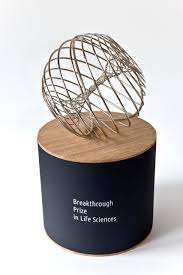The Oscars Of Science [Breakthrough Prizes]
![The Oscars Of Science [Breakthrough Prizes]](/content/images/size/w1200/wordpress/2019/11/break-through-prize-trophy.jpg)

Breakthrough Prize a.k.a “The Oscars of Science” is an award ceremony which is televised on the National Geographic Channel.
The Breakthrough Prize was founded by DST Global partner and billionaire Yuri Milner. Currently, its board member includes Cornelia I. Bargmann, Anne Wojcicki, Mark Zuckerberg, and Yuri Milner.
Breakthrough Prizes are awarded for outstanding work in the field of Life Sciences, Fundamentals of Physics and Mathematics.
This year a total prize money $21.6 Million will be awarded to hundreds of scientists who did phenomenal work in the field of Life Sciences, Physics, and Mathematics and made a mark in the advancement of science.
This 2020 Breakthrough Prize winners are:
Fundamentals Physics:
The Event Horizon Telescope Team
For the First image of a Supermassive Black Hole, taken by means of an Earth-sized alliance of telescope.
You must have seen the news and the very much shared image of the first-ever black hole.

The image was captured by the scientists working in the Event Horizon Telescope team.
The team included 347 astrophysicists spread across 60 institutions situated in 20 different countries.
A total of 8 high-powered telescopes were used to make a virtual earth-sized telescope.
The incredible collaboration of scientists and telescopes hence produced the first-ever image of a Massive M87 black hole which made the human race awe-struck and proud.
The image matched with the predictions made by Stephen Hawking.
Life Sciences:
Jeffery M. Friedman (The Rockefeller University)
For the discovery of a new endocrine system through which adipose tissue signals the brain to regulate food intake.

Jeffery M. Friedman discovered the molecular pathway that regulates body fat in 1994, but he didn’t stop just right there. Friedman discovered a hormone “Leptin” and its role in regulating body weight and obesity.
Franz-Ulrich Hartl (Max Planck Institute of Biochemistry) and Arthur L. Horwich (Yale University)
For discovering functions of molecular chaperones in mediating protein folding and preventing protein aggregation.

Hartl and Horwich discovered what is responsible for the precise folding of proteins in our body.
The discovery of an inter-cellular machinery that supports the precise folding of proteins.
After this discovery researchers are now researching on how to keep the machinery working smoothly as we age and reduce the risk of neurodegenerative diseases such as Alzheimer’s and parkinsons.
David J. Julius (University of California, San Francisco)
For discovering molecules, cells, and mechanisms underlying pain sensation.

Pain is something that has saved humans from getting burnt or harming their body.
Julius discovery has dived deep at the cellular level, how the pain signaling mechanism work and how our bodies signal pain signal to the brain.
Julius discovered that eating a chili pepper and touching a burning stove both pain signals share the same pathway and tell the brain that something is burning hot even though while eating a chili you are nowhere close to the fire.
Julies and his team is laying the foundation of non-opioid precision analgesics to deal with the chronic pain of IBS, arthritis, cancer, etc.
Virginia Man-Yee Lee (University of Pennsylvania)
For identifying TDP43 as a key protein aggregating in the cytoplasm in frontotemporal lobular dementia and amyotrophic lateral sclerosis, and for capitalizing on the toxicity of alpha-synuclein to gain insight into cellular drivers of Parkinson’s disease and multiple system atrophy.

Dr. Lee and her team developed the tau hypothesis, which posited that the cellular tangles found in the brains of Alzheimer’s patients might themselves be the cause of the neurons not firing properly. They worked to replicate the pathological evolution of the tau proteins that cause these tangles, giving neuroscientists and researchers a more thorough framework to develop treatments.
Mathematics:
Alex Eskin (University of Chicago)
For revolutionary discoveries in the dynamics and geometry of moduli spaces of Abelian differentials, including the proof of the “magic wand theorem” with Maryam Mirzakhani.

Imagine a room made out of perfect mirrors, Eskin said. It doesn’t have to be a rectangle; any weird polygon will do. (Just make sure the angles of the different walls can be expressed as ratios of whole numbers. For example, 95 degrees or two-thirds of a degree would work, but pi degrees would not.)

Now place a candle in the middle of the room, one that shines light in every direction. As the light bounces around the different corners, will it always illuminate the whole room? Or will it miss some spots? A side effect of proving the magic wand theorem, Eskin said, is that it conclusively answers this old question.
“There are no dark spots,” he said. “Every point in the room is illuminated.”
Special Breakthrough Prize in Fundamental Physics
Sergio Ferrara (CERN), Daniel Z. Freedman (MIT and Stanford), Peter van Nieuwenhuizen (Stony Brook University)
For the invention of supergravity, in which quantum variables are part of the description of the geometry of spacetime.




